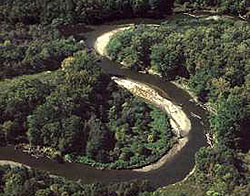 |
| The Cuyahoga River winds its way through Cuyahoga Valley National Park. |
 |
Just a short drive from the major metropolitan areas of Cleveland and Akron, Cuyahoga Valley National Park covers 33,000 acres along the banks of the Cuyahoga River. Though such a short distance from the urban environment, the park is worlds away. The winding Cuyahoga—the “crooked river,” as named by Native Americans—gives way to rolling floodplain, steep valley walls and ravines, and lush upland forests. Cuyahoga Valley National Park is a refuge for flora and fauna, and provides both recreation and solitude for northeastern Ohio’s residents and visitors.
Twenty-two miles of the river wind and weave through the Cuyahoga Valley, forming the backbone of the park. The Cuyahoga River, with its associated riparian habitat, is just one element of the park’s habitat mosaic. From deciduous mixed-mesophytic forests to wetland habitats, from currently cultivated agricultural lands to older field habitats in various stages of succession, the park’s habitats provide opportunities for plants and animals to flourish. Over 900 plant species are found in the park, as well as 194 species of birds, 91 aquatic macroinvertebrates, 43 fish, 32 mammals, 22 amphibians, and 20 species of reptiles.
But Cuyahoga Valley NP is much more than a list of species. It contains a truly unique physical environment, formed by the mingling of two diverse geographic regions—the Appalachian Plateau and the Central Lowlands—modified by the comings and goings of multiple glaciations. High above the Cuyahoga River, the landscape is rugged, with steep-sided valleys backed by high, narrow hills. Closely spaced ravines funnel tributaries, some of which drop up to 600 feet in a distance of only a few miles, toward the crooked river.
Read more about CVNP's geology in our . (720 KB)
Ohio’s only national park is a remarkable place—a place where native flora and fauna thrive, and where people come to learn, relax, and experience the natural world.
|






